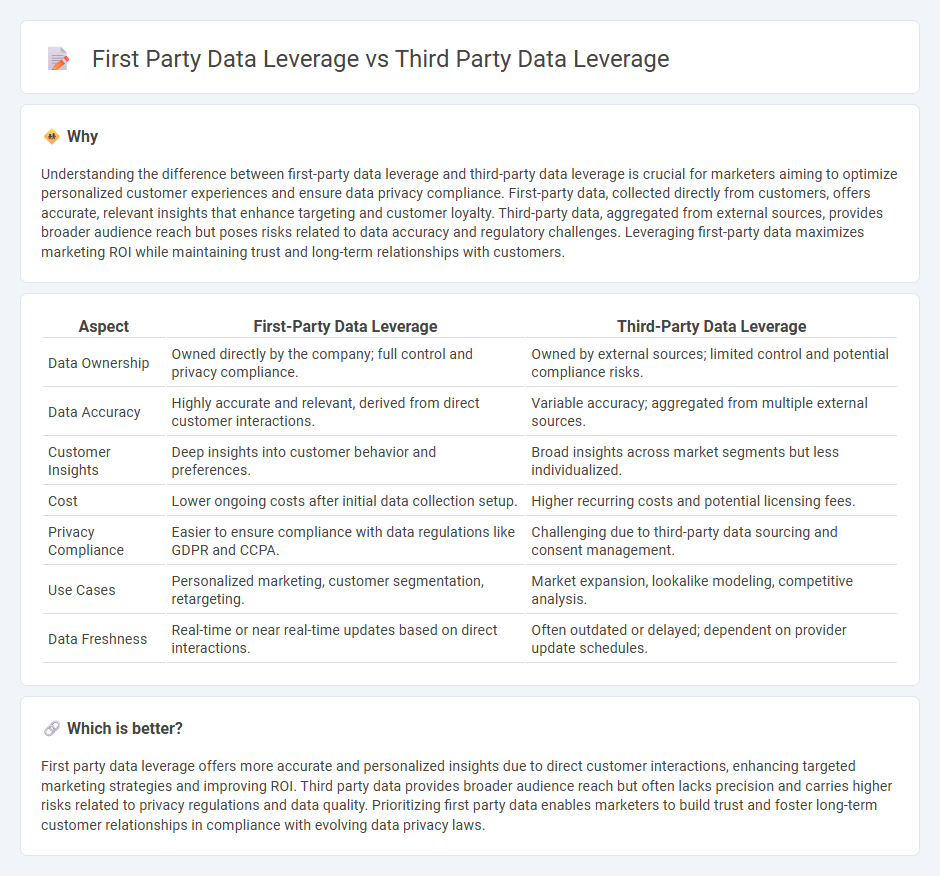
First-party data offers marketers direct insights from their own customers, ensuring higher accuracy and personalization in campaigns compared to third-party data, which is aggregated from external sources and may lack relevance and reliability. Leveraging first-party data enhances customer trust and complies better with privacy regulations, while third-party data provides broader audience reach but with less precision. Discover how optimizing first-party data can transform your marketing strategy with more effective targeting and ROI.
Why it is important
Understanding the difference between first-party data leverage and third-party data leverage is crucial for marketers aiming to optimize personalized customer experiences and ensure data privacy compliance. First-party data, collected directly from customers, offers accurate, relevant insights that enhance targeting and customer loyalty. Third-party data, aggregated from external sources, provides broader audience reach but poses risks related to data accuracy and regulatory challenges. Leveraging first-party data maximizes marketing ROI while maintaining trust and long-term relationships with customers.
Comparison Table
| Aspect | First-Party Data Leverage | Third-Party Data Leverage |
|---|---|---|
| Data Ownership | Owned directly by the company; full control and privacy compliance. | Owned by external sources; limited control and potential compliance risks. |
| Data Accuracy | Highly accurate and relevant, derived from direct customer interactions. | Variable accuracy; aggregated from multiple external sources. |
| Customer Insights | Deep insights into customer behavior and preferences. | Broad insights across market segments but less individualized. |
| Cost | Lower ongoing costs after initial data collection setup. | Higher recurring costs and potential licensing fees. |
| Privacy Compliance | Easier to ensure compliance with data regulations like GDPR and CCPA. | Challenging due to third-party data sourcing and consent management. |
| Use Cases | Personalized marketing, customer segmentation, retargeting. | Market expansion, lookalike modeling, competitive analysis. |
| Data Freshness | Real-time or near real-time updates based on direct interactions. | Often outdated or delayed; dependent on provider update schedules. |
Which is better?
First party data leverage offers more accurate and personalized insights due to direct customer interactions, enhancing targeted marketing strategies and improving ROI. Third party data provides broader audience reach but often lacks precision and carries higher risks related to privacy regulations and data quality. Prioritizing first party data enables marketers to build trust and foster long-term customer relationships in compliance with evolving data privacy laws.
Connection
First-party data leverage enhances marketing precision by utilizing direct customer interactions and behaviors collected from owned channels, establishing a foundation of trust and accuracy. Third-party data leverage supplements this by incorporating external datasets to broaden audience insights and target new potential customers beyond first-party reach. Combining both data sources creates a powerful, comprehensive strategy for personalized marketing, improving segmentation, campaign effectiveness, and return on investment.
Key Terms
Data Ownership
First party data leverage provides businesses with full data ownership, enabling direct control over data collection, storage, and usage compliant with privacy regulations like GDPR and CCPA. Third party data leverage involves acquiring data from external sources, which often limits ownership rights and may introduce compliance and accuracy challenges. Explore how maximizing first party data ownership can enhance personalized marketing strategies and regulatory adherence.
Privacy Compliance
First party data leverage ensures direct consent from users, aligning closely with GDPR and CCPA privacy regulations, thus minimizing legal risks and enhancing trust. Third party data often faces scrutiny due to opaque collection methods and less stringent compliance, increasing potential privacy violations and regulatory penalties. Explore comprehensive strategies to maximize data value while maintaining strict privacy compliance.
Targeting Precision
Third-party data offers broad audience insights but often lacks the precision and reliability inherent in first-party data collected directly from user interactions. First-party data enables highly accurate targeting by reflecting genuine customer behavior and preferences, enhancing campaign effectiveness and personalization. Explore how leveraging first-party data can transform your targeting strategies for superior results.
Source and External Links
How Financial Services Companies Can Leverage Third-Party Data in Their Analytics - This resource explores how financial institutions can utilize third-party data to enhance forecasting, decision-making, and customer experiences without relying on traditional inefficient methods.
What Is Third Party Data? A Comprehensive Guide - This guide provides insights into how businesses can leverage third-party data to expand market reach, understand broader consumer behaviors, and enhance marketing strategies.
Best Practices for Leveraging Third-Party Data in Your Analytics - This resource outlines best practices for integrating third-party data into analytics to improve data-driven decision-making and reduce time-to-insight in organizations.
 dowidth.com
dowidth.com